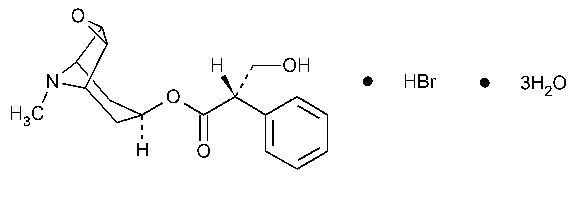Scopolamine Hydrobromide
Benzeneacetic acid,a-(hydroxymethyl)-,9-methyl-3-oxa-9-azatricyclo[3.31.0.2,4]non-[7-yl ester,hydrobromide,trihydrate,[7(S)-(1a,2b,4b,5a,7b)]-.
6b,7b-Epoxy-1aH,5aH-tropan-3a-ol (-)-tropate (ester)hydrobromide trihydrate [6533-68-2].
Anhydrous 384.27 [114-49-8].
»Scopolamine Hydrobromide contains not less than 98.5percent and not more than 102.0percent of C17H21NO4·HBr,calculated on the anhydrous basis.
Caution—Handle Scopolamine Hydrobromide with exceptional care,since it is highly potent.
Packaging and storage—
Preserve in tight,light-resistant containers.
Identification—
A:
Dissolve 3mg in 1mLof alcohol,and evaporate the solution on a steam bath to dryness.Dissolve the residue in 0.5mLof chloroform,add 200mg of potassium bromide and 15mLof ether,and stir frequently during 5minutes.Decant the solvent,dry the residue on a steam bath until the odor of the solvent no longer is perceptible,and compress the residue to a disk:the IRabsorption spectrum of the resulting potassium bromide dispersion,previously dried at 105 for 3hours,exhibits maxima only at the same wavelengths as that of a similar preparation of USP Scopolamine Hydrobromide RS,treated in the same manner.
for 3hours,exhibits maxima only at the same wavelengths as that of a similar preparation of USP Scopolamine Hydrobromide RS,treated in the same manner.
B:
To 1mLof a solution (1in 20)add a few drops of chlorine TS,and shake the mixture with 1mLof chloroform:the latter assumes a brownish color.
Specific rotation á781Sñ:
between -24 and -26
and -26 .
.
Test solution:
an amount equivalent to 50mg of anhydrous Scopolamine Hydrobromide per mL,in water.
pHá791ñ:
between 4.0and 5.5,in a solution (1in 20).
Water,Method IIIá921ñ—
Dry it in two stages (see Loss on drying á731ñ);first at 80 for 2hours,and then at 105
for 2hours,and then at 105 for an additional 3hours:it loses not more than 13.0%of its weight.
for an additional 3hours:it loses not more than 13.0%of its weight.
Residue on ignition á281ñ:
negligible,from 100mg.
Limit of apoatropine—
To 15mLof a solution (1in 100)add 0.05mLof 0.1Npotassium permanganate VS:the solution is not completely decolorized within 5minutes.
Other foreign alkaloids—
To 1mLof a solution (1in 20)add a few drops of 6Nammonium hydroxide:no turbidity is produced.Add 1Npotassium hydroxide to another 1-mLportion of the solution:only a transient whitish turbidity is produced.
Organic volatile impurities,Method Iá467ñ:
meets the requirements.
Assay—
Dissolve about 750mg of Scopolamine Hydrobromide,accurately weighed,in a mixture of 30mLof glacial acetic acid and 10mLof mercuric acetate TS,warming slightly to effect solution.Cool the solution to room temperature,add 2drops of crystal violet TS,and titrate with 0.1Nperchloric acid VS.Perform a blank determination,and make any necessary correction.Each mLof 0.1Nperchloric acid is equivalent to 38.43mg of C17H21NO4·HBr.
Auxiliary Information—
Staff Liaison:Lawrence Evans,III,Ph.D.,Scientist
Expert Committee:(PA6)Pharmaceutical Analysis 6
USP28–NF23Page 1756
Pharmacopeial Forum:Volume No.28(6)Page 1868
Phone Number:1-301-816-8389
